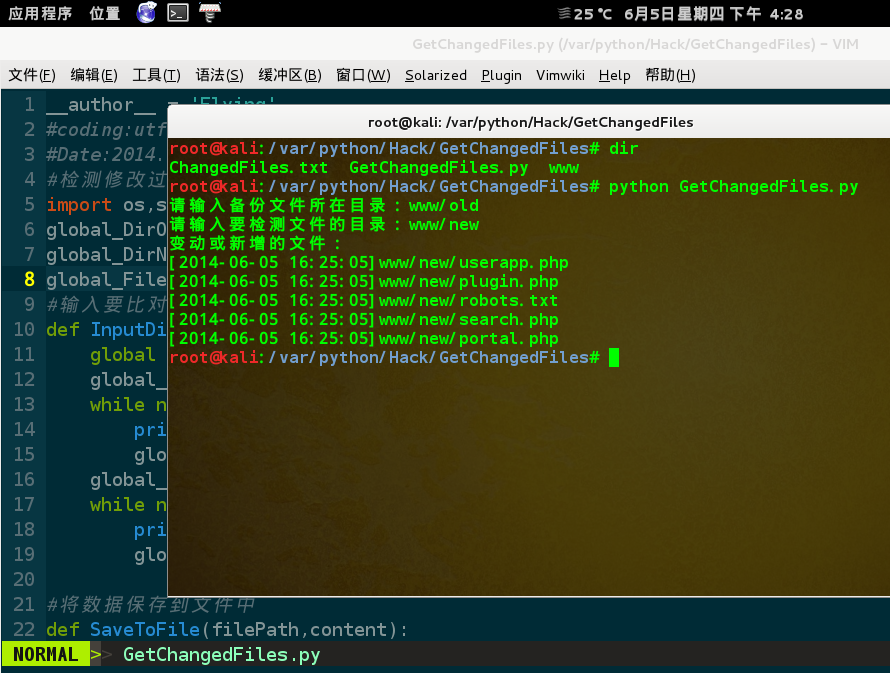Python实例分享:快速查找出被挂马的文件
思路
需要实现准备一份未受感染的源代码和一份可能受感染的源代码,然后运行以下脚本,就能找出到底哪些文件被挂马了。
其中,主要是根据比对2份文件的md5值来过滤可能被挂马的文件(确切的说应该是被修改过的文件)
Python脚本
__author__ = 'Flying'
#coding:utf-8
#Date:2014.6.5
#检测修改过的文件
import os,sys,hashlib,datetime
global_DirOld = ""
global_DirNew = ""
global_FilesList = []
#输入要比对的文件路径
def InputDirPath():
global global_DirOld,global_DirNew
global_DirOld = unicode(raw_input("请输入备份文件所在目录:"),"utf-8")
while not os.path.exists(global_DirOld):
print u"指定的路径不存在,请重新输入"
global_DirOld = unicode(raw_input("请输入备份文件所在目录:"),"utf-8")
global_DirNew = unicode(raw_input("请输入要检测文件的目录:"),"utf-8")
while not os.path.exists(global_DirNew):
print u"指定的路径不存在,请重新输入"
global_DirNew = unicode(raw_input("请输入要检测文件的目录:"),"utf-8")
#将数据保存到文件中
def SaveToFile(filePath,content):
try:
f = open(filePath,"a+")
f.write(content.encode("utf-8") + "\n")
f.close()
except Exception,ex:
print "Error:" + str(ex)
#计算文件的MD5值
def CalcMD5(filepath):
try:
#以二进制的形式打开
with open(filepath,'rb') as f:
md5obj = hashlib.md5()
md5obj.update(f.read())
hash = md5obj.hexdigest()
return hash
except Exception,ex:
print "Error:" + str(ex)
return None
#遍历目录下的所有文件
def GetAllSubFiles():
global global_FilesList
for dir in os.walk(global_DirNew):
for file in dir[2]:
filePath = dir[0] + os.sep + file
global_FilesList.append(filePath[len(global_DirNew)+1:])
#列出新增文件和变动的文件
def ListChangedFiles():
global global_DirOld,global_DirNew,global_FilesList
print u"变动或新增的文件:"
for file in global_FilesList:
filePathOld = global_DirOld + os.sep + file
filePathNew = global_DirNew + os.sep + file
if not os.path.exists(filePathOld) or CalcMD5(filePathOld)!=CalcMD5(filePathNew):
content = "[" + datetime.datetime.now().strftime('%Y-%m-%d %H:%M:%S')+ "]" + filePathNew
print content
SaveToFile("ChangedFiles.txt",content)
if __name__=="__main__":
InputDirPath()
GetAllSubFiles()
ListChangedFiles()
脚本执行结果


Hot AI Tools

Undresser.AI Undress
AI-powered app for creating realistic nude photos

AI Clothes Remover
Online AI tool for removing clothes from photos.

Undress AI Tool
Undress images for free

Clothoff.io
AI clothes remover

Video Face Swap
Swap faces in any video effortlessly with our completely free AI face swap tool!

Hot Article

Hot Tools

Notepad++7.3.1
Easy-to-use and free code editor

SublimeText3 Chinese version
Chinese version, very easy to use

Zend Studio 13.0.1
Powerful PHP integrated development environment

Dreamweaver CS6
Visual web development tools

SublimeText3 Mac version
God-level code editing software (SublimeText3)

Hot Topics
 1675
1675
 14
14
 1429
1429
 52
52
 1333
1333
 25
25
 1278
1278
 29
29
 1257
1257
 24
24
 PHP and Python: Different Paradigms Explained
Apr 18, 2025 am 12:26 AM
PHP and Python: Different Paradigms Explained
Apr 18, 2025 am 12:26 AM
PHP is mainly procedural programming, but also supports object-oriented programming (OOP); Python supports a variety of paradigms, including OOP, functional and procedural programming. PHP is suitable for web development, and Python is suitable for a variety of applications such as data analysis and machine learning.
 Choosing Between PHP and Python: A Guide
Apr 18, 2025 am 12:24 AM
Choosing Between PHP and Python: A Guide
Apr 18, 2025 am 12:24 AM
PHP is suitable for web development and rapid prototyping, and Python is suitable for data science and machine learning. 1.PHP is used for dynamic web development, with simple syntax and suitable for rapid development. 2. Python has concise syntax, is suitable for multiple fields, and has a strong library ecosystem.
 How to run sublime code python
Apr 16, 2025 am 08:48 AM
How to run sublime code python
Apr 16, 2025 am 08:48 AM
To run Python code in Sublime Text, you need to install the Python plug-in first, then create a .py file and write the code, and finally press Ctrl B to run the code, and the output will be displayed in the console.
 PHP and Python: A Deep Dive into Their History
Apr 18, 2025 am 12:25 AM
PHP and Python: A Deep Dive into Their History
Apr 18, 2025 am 12:25 AM
PHP originated in 1994 and was developed by RasmusLerdorf. It was originally used to track website visitors and gradually evolved into a server-side scripting language and was widely used in web development. Python was developed by Guidovan Rossum in the late 1980s and was first released in 1991. It emphasizes code readability and simplicity, and is suitable for scientific computing, data analysis and other fields.
 Python vs. JavaScript: The Learning Curve and Ease of Use
Apr 16, 2025 am 12:12 AM
Python vs. JavaScript: The Learning Curve and Ease of Use
Apr 16, 2025 am 12:12 AM
Python is more suitable for beginners, with a smooth learning curve and concise syntax; JavaScript is suitable for front-end development, with a steep learning curve and flexible syntax. 1. Python syntax is intuitive and suitable for data science and back-end development. 2. JavaScript is flexible and widely used in front-end and server-side programming.
 Golang vs. Python: Performance and Scalability
Apr 19, 2025 am 12:18 AM
Golang vs. Python: Performance and Scalability
Apr 19, 2025 am 12:18 AM
Golang is better than Python in terms of performance and scalability. 1) Golang's compilation-type characteristics and efficient concurrency model make it perform well in high concurrency scenarios. 2) Python, as an interpreted language, executes slowly, but can optimize performance through tools such as Cython.
 Where to write code in vscode
Apr 15, 2025 pm 09:54 PM
Where to write code in vscode
Apr 15, 2025 pm 09:54 PM
Writing code in Visual Studio Code (VSCode) is simple and easy to use. Just install VSCode, create a project, select a language, create a file, write code, save and run it. The advantages of VSCode include cross-platform, free and open source, powerful features, rich extensions, and lightweight and fast.
 How to run python with notepad
Apr 16, 2025 pm 07:33 PM
How to run python with notepad
Apr 16, 2025 pm 07:33 PM
Running Python code in Notepad requires the Python executable and NppExec plug-in to be installed. After installing Python and adding PATH to it, configure the command "python" and the parameter "{CURRENT_DIRECTORY}{FILE_NAME}" in the NppExec plug-in to run Python code in Notepad through the shortcut key "F6".




